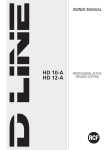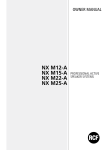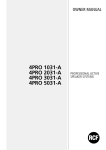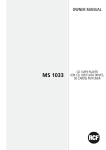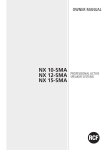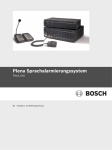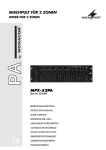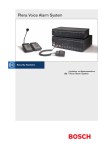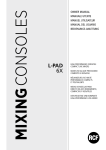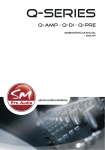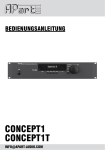Download PR4092
Transcript
OWNER MANUAL PR4092 9 INPUTS - 2 OUTPUTS PA PREAMPLIFIER ENGLISH LANGUAGE ENGLISH ITALIANO DEUTSCH 2 3 12 21 ENGLISH SAFETY PRECAUTIONS Before connecting and using this product, please read this instruction manual carefully and keep it on hand for future reference. The manual is to be considered an integral part of this product and must accompany it when it changes ownership as a reference for correct installation and use as well as for the safety precautions. RCF S.p.A. will not assume any responsibility for the incorrect installation and / or use of this product. IMPORTANT NOTES WARNING: To prevent the risk of fire or electric shock, never expose this product to rain or humidity (except in case it has been expressly designed and made for outdoor use). WARNING SAFETY PRECAUTIONS 1. All the precautions, in particular the safety ones, must be read with special attention, as they provide important information. 2.1 Power supply from mains (direct connection) a. The mains voltage is sufficiently high to involve a risk of electrocution; therefore, never install or connect this product with the power supply switched on. b. Before powering up, make sure that all the connections have been made correctly and the voltage of your mains corresponds to the voltage shown on the rating plate on the unit, if not, please contact your RCF dealer. c. The metallic parts of the unit are earthed by means of the power cable. In the event that the current outlet used for power does not provide the earth connection, contact a qualified electrician to earth this product by using the dedicated terminal. d. Protect the power cable from damage; make sure it is positioned in a way that it cannot be stepped on or crushed by objects. e. To prevent the risk of electric shock, never open the product: there are no parts inside that the user needs to access. 2.2 Power supply by means of an external adapter a. Use the dedicated adapter only; verify the mains voltage corresponds to the voltage shown on the adapter rating plate and the adapter output voltage value and type (direct / alternating) corresponds to the product input voltage, if not, please contact your RCF dealer; verify also that the adapter hasn’t been damaged due to possible clashes / hits or overloads. b. The mains voltage, which the adapter is connected to, is sufficiently high to involve a risk of electrocution: pay attention during the connection (i.e. never do it with wet hands) and never open the adapter. c. Make sure that the adapter cable is not (or cannot be) stepped on or crushed by other objects (pay particular attention to the cable part near the plug and the point where it leads out from the adapter). 3. Make sure that no objects or liquids can get into this product, as this may cause a short circuit. 4. Never attempt to carry out any operations, modifications or repairs that are not expressly described in this manual. Contact your authorized service centre or qualified personnel should any of the following occur: -- the product does not function (or functions in an anomalous way); -- the power supply cable has been damaged; -- objects or liquids have got into the unit; -- the product has been subject to a heavy impact. 5. If this product is not used for a long period, switch it off and disconnect the power cable. 6. If this product begins emitting any strange odours or smoke, switch it off immediately and disconnect the power supply cable. 3 ENGLISH 7. Do not connect this product to any equipment or accessories not foreseen. For suspended installation, only use the dedicated anchoring points and do not try to hang this product by using elements that are unsuitable or not specific for this purpose. Also check the suitability of the support surface to which the product is anchored (wall, ceiling, structure, etc.), and the components used for attachment (screw anchors, screws, brackets not supplied by RCF etc.), which must guarantee the security of the system / installation over time, also considering, for example, the mechanical vibrations normally generated by transducers. To prevent the risk of falling equipment, do not stack multiple units of this product unless this possibility is specified in the instruction manual. 8. RCF S.p.A. strongly recommends this product is only installed by professional qualified installers (or specialised firms) who can ensure correct installation and certify it according to the regulations in force. The entire audio system must comply with the current standards and regulations regarding electrical systems. 9. Supports and trolleys The equipment should be only used on trolleys or supports, where necessary, that are recommended by the manufacturer. The equipment / support / trolley assembly must be moved with extreme caution. Sudden stops, excessive pushing force and uneven floors may cause the assembly to overturn. 10. There are numerous mechanical and electrical factors to be considered when installing a professional audio system (in addition to those which are strictly acoustic, such as sound pressure, angles of coverage, frequency response, etc.). 11. Hearing loss Exposure to high sound levels can cause permanent hearing loss. The acoustic pressure level that leads to hearing loss is different from person to person and depends on the duration of exposure. To prevent potentially dangerous exposure to high levels of acoustic pressure, anyone who is exposed to these levels should use adequate protection devices. When a transducer capable of producing high sound levels is being used, it is therefore necessary to wear ear plugs or protective earphones. See the technical specifications in the instruction manual for the maximum sound pressure the loudspeaker is capable of producing. IMPORTANT NOTES To prevent the occurrence of noise on the cables that carry microphone signals or line signals (for example, 0 dB), only use screened cables and avoid running running them in the vicinity of: -- equipment that produces high-intensity electromagnetic fields (for example, high power transformers); -- mains cables; -- lines that supply loudspeakers. OPERATING PRECAUTIONS -- Do not obstruct the ventilation grilles of the unit. Situate this product far from any heat sources and always ensure adequate air circulation around the ventilation grilles. -- Do not overload this product for extended periods of time. -- Never force the control elements (keys, knobs, etc. ). -- Do not use solvents, alcohol, benzene or other volatile substances for cleaning the external parts of this product. 4 IMPORTANT NOTES ENGLISH PRODUCT INFORMATIONS RCF S.p.A. would like to thank you for having purchased this product, which has been designed to guarantee reliability and high performance. The PR 4092 preamplifier has been specifically designed for the public broadcasting of announcements and/or musical programs in all audio systems. Each of the 9 inputs can be sent to output “A” only, to output “B” only, or to both. The equipment can therefore be used as a double preamplifier (for example: output “A” reserved for microphone announcements; output “B” reserved for background music). Input no. 1 has absolute priority (activated both by means of a contact and by the presence of a signal); inputs nos. 2 and 3 can be given priority over the subsequent inputs; an input’s priority function is active only at the output selected (or both). -- 1 microphone input (no. 1; XLR connector) with absolute priority activated both (auto) in the presence of a signal (VOX) and by contact; signal indicator (LED) -- 8 universal inputs, each with MIC / LINE selector and signal indicator (LED), located on the front panel: inputs nos. 2, 3, 4, and 5, with XLR connector (MIC / LINE) inputs nos. 6, 7, 8 and 9, with XLR connector (MIC) and double RCA (LINE) -- “Phantom” feed (can be inactivated by group) at the microphone inputs - 2 balanced outputs with XLR connector - double “REC” output (double RCA connector) -- inputs 2 and 3 given priority over subsequent inputs by means of vocal activation (excludable) -- warning signal (3-tone) activated by means of contact (input 1) or the “CHIME TEST” button the front panel - level control (with VU meter) for each of the two outputs -- bass- and treble-tone control for each output -- alternating-current power supply (230 V - 50 Hz / 115 V - 60 Hz) -- direct current power supply (24 V). MAIN CHARACTERISTICS FRONT PANEL 1 2 5 4 7 8 6 3 1 CHIME. Pressing the “CHIME TEST” button sends a warning signal (3-tone) to the output selected, making it possible to regulate its level by means of the relative volume control. 2 VOLUME CONTROL (CHIME, INPUTS 1÷9). Makes it possible to set the signal level of the relative input. Note: the level must be regulated so that the signal is optimal at the output selected but without the peak indicator (read LED “PEAK”) lighting up. 5 ENGLISH 3 OUTPUT SELECTOR (CHIME, INPUTS 1÷9). Makes it possible to direct the signal to output “A” only, to output “B” only, or to both. Note: the priority function (inputs 1, 2 and 3) is active only at the output selected. When a priority is active, it could happen that sources assigned to one output are present at lower level on the other output as well. 4 SIGNAL-PRESENCE INDICATOR (GREEN LED; INPUTS 1÷9). Lights up in the presence of an input signal. 5 MIC / LINE LEVEL SELECTOR (INPUTS 2÷9). The selector has 3 positions: - MIC: microphone signal with high-pass filter inserted (cut-off frequency: 300 Hz) - MIC: microphone signal - LINE: high-level signal (CD player, cassette deck, radio tuner). Note: - the “MIC” positions activate the PHANTOM feed to the microphone inputs (with XLR connector), to which it is advisable to connect only microphones (electret, condenser, etc.) that need this feed. If dynamic microphones are used, it is necessary for the cable to be balanced in order to avoid possible malfunctioning and/or damage to the microphones. Alternatively, the PHANTOM feed can be removed from some of the inputs by using the internal jumpers (JP3 - JP6). - the level selector also enables the connector (to be used) of the 6÷9 inputs: XLR in the 2 MIC positions: double RCA in the “LINE” position. 6 “PRIORITY” BUTTON (INPUTS 2 AND 3). When pressed, it enables the vocal-activation priority of inputs 2 and 3 (note: the presence of any signal at inputs 2 and 3 activates the priority function). 7 AUDIO-OUTPUT CONTROLS. Each output has the following controls: - a volume control; - a bass-tone control (100 Hz); - a treble-tone control (10 kHz); - a VU METER consisting of 5 LEDs (corresponding to these levels: -20 dBu, -10 dBu, -3 dBu, 0 dBu, “peak”). 8 “POWER” ON/OFF BUTTON WITH LIGHT (GREEN LED) “ON”. Turns the equipment on and off. REAR PANEL 9 10 11 12 13 14 9 POWER-SUPPLY CABLE PLUG (230-115 V AC) WITH FUSE. For connecting the power cable supplied. 10 24-V DC FEED CLAMPS. The 2 clamps make it possible to power the preamplifier with direct current from an external source (batteries, for example). If the usual power supply is unavailable or suddenly cuts out, the equipment can be powered with direct current, thus ensuring continuous operation. 11 MAIN AUDIO OUTPUTS “A” AND “B”. Balanced audio outputs with XLR connectors. 6 15 16 ENGLISH 12 AUDIO OUTPUTS “REC” “A” AND“B”. Outputs (unbalanced, with RCA connectors) for connecting a recording device (or other device). Note: the signal level is not regulated by the main outputs’ volume controls. 13 HIGH-LEVEL (“LINE”) AUDIO INPUTS 6÷9. Double-line inputs (RCA connectors for stereo music sources) with -10dBu (245 mV) sensitivity. The right and left channels are combined, resulting in a single mono signal that can be directed to one or both the audio outputs. 14 MICROPHONE AUDIO INPUTS 6÷9. Balanced audio inputs for microphones (XLR connectors). 15 Audio inputs 2÷5. Balanced audio inputs (XLR connectors). The “MIC / LINE” level can be selected with the relative switches on the front panel. 16 Single microphone audio input for announcements; controls. Balanced audio input (XLR connector) for announcement microphone, with terminal board having the following commands: - CHIME: if grounded, activates the warning signals; - PRIORITY: if grounded, gives absolute priority to input 1; - GROUND: earth; - VDC LED: feed output for an LED. INSTALLATION - Do not set up the equipment in places subject to high-intensity vibrations or particularly exposed to dust or humidity. - The container rack must conform to the EN 60439-1 standard; in particular, the back must be closed with appropriate panels. CONNECTIONS To avoid inductive phenomena that might give rise to hum or other disturbances and compromise the equipment’s proper functioning, the connection cables that carry the audio signals must not be near: 1) equipment that produces strong magnetic fields (large power-supply transformers, for example); 2) electric-energy conductors; 3) lines that feed diffusers. DC POWER SUPPLY WARNING: When the equipment is fed with direct current, do not disconnect the powersupply cord. This is in order to keep the equipment grounded. The equipment is not equipped with a device for recharging batteries. An appropriate device should therefore be considered. WARNING 7 SPECIFICATIONS INPUTS Sensitivity, Impedance Phantom Power OUTPUTS Voltage, Impedance FREQUENCY RESPONSE 12 V, 10 mA MASTER 1,2: nor. +4 dBu (1,23 V), 200 Ω balanced REC: nor. 0 dBu (775 mV), 2.2 KΩ unbalanced 20 ÷ 20’000 Hz SIGNAL/NOISE AND CROSSTALK MIC: > 60 dB DIAPHONIA LINE: > 75 dB DISTORTION (T.H.D.) MIC: < 0,5 % LINE: < 0,3 % CONTROLS TONE CONTROLS FEED, CONSUMPTION MAXIMUM 24-V ABSORPTION MAXIMUM AMBIENT TEMPERATURE DIMENSIONS WEIGHT 8 MIC (XLR): - 50 dBu (2,45 mV), 5 kΩ balanced LINE (XLR): -10 dBu (245 mV), 5 kΩ balanced LINE (RCA): -10 dBu (245 mV), 10 kΩ unbalanced 9 volume controls per input - 1 “CHIME” volume control - 2 general volume controls - 2 bass-tone controls - 2 treble-tone controls BASS: 100 Hz ± 10 dB TREBLE: 10 kHz ± 10 dB 230 V - 50 Hz / 115 V - 60 Hz, 10 VA (alternating current) 450 mA (direct-current) 55° C 483 x 44 x 200 mm (1 rack unit) 3.9 kg ENGLISH SECTION RESERVED FOR RCF SERVICE CENTERS WARNING: The operations described in this section are intended exclusively RCF S.p.A. SERVICE CENTERS. The following information DOES NOT CONCERN THE USER, who may omit reading. Before carrying out the operations described in this section, the power-supply must be disconnected from the direct-current power source. WARNING Voltage selector is under a cover on the bottom of the device. Pls remove screw and select right voltage according to the AC mains. FEED-VOLTAGE SELECTION The MAIN CHART (found inside the preamplifier) shows the jumpers that the selection of some of the equipment’s operating modes. The function of each jumper is given in the following table. INTERNAL JUMPER CONFIGURATION NAME “ON” POSITION (jumper short-circuited) “OFF” POSITION (jumper open) JP 1 CHIME MUTE ON THE WARNING SIGNAL (“CHIME”) HAS PRIORITY ON INPUTS 2÷9 THE WARNING SIGNAL DOES NOT HAVE PRIORITY BUT IS MIXED WITH ALL JP 2 IN 1 MUTE INPUT 1 HAS AUTOMATIC PRIORITY IN THE PRESENCE OF A SIGNAL (VOX) INPUT 1 DOES NOT HAVE AUTOMATIC PRIORITY (Note: priority may, however, be activated by means of a remote contact connected to the “priority” and “ground” clamps) JP 3 IN 2 PHANTOM PHANTOM FEED AT INPUT 2 NO PHANTOM FEED AT INPUT 2 JP 4 IN 3 PHANTOM PHANTOM FEED AT INPUT 3 NO PHANTOM FEED AT INPUT 3 JP 5 IN 4-5 PHANTOM PHANTOM FEED AT INPUTS 4, 5 NO PHANTOM FEED INPUTS 4, 5 JP 6 IN 6÷9 PHANTOM PHANTOM FEED AT INPUTS 6÷9 NO PHANTOM FEED AT INPUT 6÷9 9 ENGLISH Balanced Signal Input HOT COLD GND 3 - pin XLR socket Connection to the XLR socket (balanced signal). Do not turn Phantom Power on. Unbalanced Signal Input GND 3 - pin XLR socket Connection to the XLR socket (unbalanced signal). Do not turn Phantom Power on. Audio Signal (right or left channel) GND RCA plug Connection of the RCA plugs. HOT COLD Output Connection to the main audio outputs (XLR plug, balanced signal. 10 GND Balanced signal ENGLISH CHIME PRIO GND VDC LED CHIME activation by means of contact. Input 1 priority activation by means of contact. CHIME PRIO GND VDC LED LED feed. 11 ITALIANO AVVERTENZE PER LA SICUREZZA Prima di collegare ed utilizzare questo prodotto, leggere attentamente le istruzioni contenute in questo manuale, il quale è da conservare per riferimenti futuri. Il presente manuale costituisce parte integrante del prodotto e deve accompagnare quest’ultimo anche nei passaggi di proprietà, per permettere al nuovo proprietario di conoscere le modalità d’installazione e d’utilizzo e le avvertenze per la sicurezza. L’installazione e l’utilizzo errati del prodotto esimono la RCF S.p.A. da ogni responsabilità. IMPORTANTE ATTENZIONE: Per prevenire i rischi di fiamme o scosse elettriche, non esporre mai questo prodotto alla pioggia o all’umidità (salvo il caso in cui sia stato espressamente progettato e costruito per l’uso all’aperto). ATTENZIONE AVVERTENZE PER LA SICUREZZA 1. Tutte le avvertenze, in particolare quelle relative alla sicurezza, devono essere lette con particolare attenzione, in quanto contengono importanti informazioni. 2.1 Alimentazione diretta da rete a. La tensione di alimentazione dell’apparecchio ha un valore sufficientemente alto da costituire un rischio di folgorazione per le persone: non procedere mai all’installazione o connessione dell’apparecchio con l’alimentazione inserita. b. Prima di alimentare questo prodotto, assicurarsi che tutte le connessioni siano corrette e che la tensione della vostra rete di alimentazione corrisponda quella di targa dell’apparecchio, in caso contrario rivolgetevi ad un rivenditore RCF. c. Le parti metalliche dell’apparecchio sono collegate a terra tramite il cavo di alimentazione. Nel caso la presa di corrente utilizzata per l’alimentazione non fornisca il collegamento con la terra, contattare un elettricista qualificato, che provvederà a connettere a terra l’apparecchio tramite l’apposito morsetto. d. Accertarsi che il cavo di alimentazione dell’apparecchio non possa essere calpestato o schiacciato da oggetti, al fine di salvaguardarne la perfetta integrità. e. Per evitare il rischio di shock elettrici, non aprire mai l’apparecchio: all’interno non vi sono parti che possono essere utilizzate dall’utente. 2.2 Alimentazione tramite alimentatore esterno a. Alimentare il prodotto utilizzando solo l’alimentatore dedicato; verificare che la tensione della vostra rete corrisponda quella di targa dell’alimentatore e che il valore ed il tipo (continua o alternata) di tensione d’uscita dello stesso corrisponda a quella d’ingresso del prodotto, in caso contrario rivolgersi ad un rivenditore RCF; verificare inoltre che l’alimentatore non sia stato danneggiato da eventuali urti o sovraccarichi. b. La tensione di rete, alla quale è connesso l’alimentatore, ha un valore sufficientemente alto da costituire un rischio di folgorazione per le persone: prestare attenzione durante la connessione alla rete (es. non effettuarla con le mani bagnate) e non aprire mai l’alimentatore. c. Accertarsi che il cavo dell’alimentatore non sia o possa essere schiacciato da altri oggetti (prestando particolare attenzione alla parte del cavo vicino alla spina ed al punto dove questo esce dall’alimentatore). 3. Impedire che oggetti o liquidi entrino all’interno del prodotto, perché potrebbero causare un corto circuito. 4. Non eseguire sul prodotto interventi / modifiche / riparazioni se non quelle espressamente descritte sul manuale istruzioni. Contattare centri di assistenza autorizzati o personale altamente qualificato quando: -- l’apparecchio non funziona (o funziona in modo anomalo); -- il cavo di alimentazione ha subito gravi danni; -- oggetti o liquidi sono entrati nell’apparecchio; -- l’apparecchio ha subito forti urti. 5. Qualora questo prodotto non sia utilizzato per lunghi periodi, togliere la tensione dal cavo di alimentazione (o scollegare l’alimentatore esterno). 12 ITALIANO 6. Nel caso che dal prodotto provengano odori anomali o fumo, spegnerlo immediatamente e togliere la tensione dal cavo di alimentazione (o scollegare l’alimentatore esterno). 7. Non collegare a questo prodotto altri apparecchi e accessori non previsti. Quando è prevista l’installazione sospesa, utilizzare solamente gli appositi punti di ancoraggio e non cercare di appendere questo prodotto tramite elementi non idonei o previsti allo scopo. Verificare inoltre l’idoneità del supporto (parete, soffitto, struttura ecc., al quale è ancorato il prodotto) e dei componenti utilizzati per il fissaggio (tasselli, viti, staffe non fornite da RCF ecc.) che devono garantire la sicurezza dell’impianto / installazione nel tempo, anche considerando, ad esempio, vibrazioni meccaniche normalmente generate da un trasduttore. Per evitare il pericolo di cadute, non sovrapporre fra loro più unità di questo prodotto, quando questa possibilità non è espressamente contemplata dal manuale istruzioni. 8. La RCF S.p.A. raccomanda vivamente che l’installazione di questo prodotto sia eseguita solamente da installatori professionali qualificati (oppure da ditte specializzate) in grado di farla correttamente e certificarla in accordo con le normative vigenti. Tutto il sistema audio dovrà essere in conformità con le norme e le leggi vigenti in materia di impianti elettrici. 9. Sostegni e carrelli Se previsto, il prodotto va utilizzato solo su carrelli o sostegni consigliati dal produttore. L’insieme apparecchio-sostegno / carrello va mosso con estrema cura. Arresti improvvisi, spinte eccessive e superfici irregolari o inclinate possono provocare il ribaltamento dell’assieme. 10. Vi sono numerosi fattori meccanici ed elettrici da considerare quando si installa un sistema audio professionale (oltre a quelli prettamente acustici, come la pressione sonora, gli angoli di copertura, la risposta in frequenza, ecc.). 11. Perdita dell’udito L’esposizione ad elevati livelli sonori può provocare la perdita permanente dell’udito. Il livello di pressione acustica pericolosa per l’udito varia sensibilmente da persona a persona e dipende dalla durata dell’esposizione. Per evitare un’esposizione potenzialmente pericolosa ad elevati livelli di pressione acustica, è necessario che chiunque sia sottoposto a tali livelli utilizzi delle adeguate protezioni; quando si fa funzionare un trasduttore in grado di produrre elevati livelli sonori è necessario indossare dei tappi per orecchie o delle cuffie protettive. Consultare i dati tecnici contenuti nel manuale istruzioni per conoscere la massima pressione sonora che il diffusore acustico è in grado di produrre. NOTE IMPORTANTI Per evitare fenomeni di rumorosità indotta sui cavi che trasportano segnali dai microfoni o di linea (per esempio 0dB), usare solo cavi schermati ed evitare di posarli nelle vicinanze di: -- apparecchiature che producono campi elettromagnetici di forte intensità -- (per esempio trasformatori di grande di potenza); -- cavi di rete; -- linee che alimentano altoparlanti. NOTE IMPORTANTI PRECAUZIONI D’USO -- Non ostruire le griglie di ventilazione dell’unità. Collocare il prodotto lontano da fonti di calore e garantire la circolazione dell’aria in corrispondenza delle griglie di aerazione. -- Non sovraccaricare questo prodotto per lunghi periodi. -- Non forzare mai gli organi di comando (tasti, manopole ecc.). -- Non usare solventi, alcool, benzina o altre sostanze volatili per la pulitura delle parti esterne dell’unità. 13 ITALIANO DESCRIZIONE GENERALE RCF S.p.A. Vi ringrazia per l’acquisto di questo prodotto, realizzato in modo da garantirne l’affidabilità e prestazioni elevate. Il preamplificatore PR 4092 è stato espressamente studiato per la diffusione di annunci e/o programmi musicali in tutti i sistemi audio ad indirizzo pubblico. Ciascuno dei 9 ingressi può essere inviato solo all’uscita “A”, solo all’uscita “B” o ad entrambe, permettendo così un utilizzo dell’apparecchiatura come doppio preamplificatore (esempio: uscita A riservata agli annunci microfonici; uscita B riservata alla musica di sottofondo). L’ingresso nr.1 ha la priorità assoluta (attivabile sia tramite un contatto, sia con la presenza del segnale); gli ingressi nr.2, 3 possono essere resi prioritari su quelli successivi; la funzione di priorità di un ingresso è attiva solo sull’uscita selezionata (o entrambe). -- 1 ingresso microfonico (nr.1; connettore XLR) con priorità assoluta attivabile sia (aut.) in presenza di segnale (VOX), sia tramite contatto; indicatore (LED) di segnale -- 8 ingressi universali, ciascuno con selettore MIC / LINE ed indicatore (LED) di segnale posti sul pannello frontale: ingressi nr. 2,3,4,5 con connettore XLR (MIC / LINEA) ingressi nr. 6,7,8,9 con connettore XLR (MIC) e doppio RCA (LINEA) -- alimentazione “Phantom” (disattivabile a gruppi) presente agli ingressi microfonici -- 2 uscite bilanciate con connettore XLR -- doppia uscita “REC” (doppio connettore RCA) -- priorità degli ingressi 2 e 3 su quelli successivi tramite attivazione vocale (escludibile) -- segnale di preavviso (3 toni) attivabile tramite contatto (ingresso 1) o pulsante “CHIME TEST” sul pannello frontale -- controllo di livello (con VU meter) per ciascuna delle 2 uscite -- controllo toni bassi e alti per ciascuna uscita -- alimentazione in corrente alternata (230 V - 50 Hz / 115 V - 60 Hz ) -- alimentazione in corrente continua (24 V) CARATTERISTICHE PRINCIPALI PANNELLO FRONTALE 1 2 5 6 3 1 CHIME. Premendo il pulsante “CHIME TEST” si invia il segnale di preavviso (3 toni) verso l’uscita selezionata, permettendo di regolarne il livello tramite il relativo controllo di volume. 2 Controllo di volume (chime, ingressi 1 ÷ 9). Permette di impostare il livello del segnale del relativo ingresso. Nota: occorre regolarlo in modo che il livello del segnale sia ottimale sull’uscita selezionata, ma non si accenda l’indicatore di picco (LED rosso“PEAK”). 14 4 7 8 ITALIANO 3 SELETTORE USCITA (CHIME, INGRESSI 1 ÷ 9). Permette di indirizzare il segnale solo verso l’uscita “A”, solo l’uscita “B” od entrambe. Nota: la funzione priorità (ingressi 1,2,3) è attiva solo sull’uscita selezionata. Può accadere che sorgenti assegnate ad una uscita siano presenti con segnale residuo sull’altra uscita quando è attiva una priorità. 4 INDICATORE PRESENZA DI SEGNALE (LED VERDE; INGRESSI 1 ÷ 9). Si accende in presenza di segnale all’ingresso. 5 Selettore livello mic. / line (ingressi 2 ÷ 9). Il selettore presenta 3 posizioni: - MIC segnale microfonico con filtro passa-alto inserito (freq. di taglio: 300 Hz) - MIC segnale microfonico - LINE segnale ad alto livello (lettori CD, cassette, sintonizzatori radio) Note: - le posizioni “MIC” attivano l’alimentazione PHANTOM sugli ingressi microfonici (con connettore XLR), ai quali è consigliabile connettere solo microfoni che necessitano di tale alimentazione (ad elettrete, a condensatore). Nel caso si utilizzino microfoni dinamici, è necessario che il cavo sia bilanciato per evitare possibili malfunzionamenti e danni ai microfoni stessi, oppure è possibile togliere l’alimentazione PHANTOM ad alcuni ingressi tramite l’impostazione dei ponticelli (jumpers JP3 ÷ JP6) interni. - il selettore di livello abilita anche il connettore (da utilizzarsi) degli ingressi 6 ÷ 9: XLR nelle 2 posizioni “MIC”; doppio RCA nella posizione “LINE”. 6 Tasto “PRIORITY” (ingressi 2 e 3). Se premuto, abilita la priorità ad attivazione vocale degli ingressi 2 e 3 (nota: la presenza di un qualsiasi segnale agli ingressi 2 o 3 attiva la funzione di priorità) 7 Controlli uscite audio. Sono presenti (per ciascuna uscita): - un controllo di volume; - un controllo toni bassi (100 Hz); - un controllo toni alti (10 kHz) - un VU METER composto da 5 LED (corrispondenti ai livelli: -20 dBu, -10 dBu, -3 dBu, 0 dBu, “PEAK”). 8 Interruttore “POWER” con spia “ON” (LED verde). Permette l’accensione e lo spegnimento dell’apparecchio. PANNELLO POSTERIORE 9 10 11 12 13 14 15 16 9 Presa per cavo di alimentazione da rete (230-115 V ac) con fusibile. Consente la connessione del cavo di alimentazione fornito in dotazione. 10 Morsetti alimentazione 24 V dc. I 2 morsetti consentono di alimentare il preamplificatore in corrente continua tramite una fonte esterna (es. batterie). Nel caso la tensione di rete non sia disponibile o manchi improvvisamente, l’apparecchio può essere alimentato in corrente continua assicurando la continuità del funzionamento. 15 ITALIANO 11 Uscite audio principali “A” e “B”. Uscite audio bilanciate con connettori XLR. 12 Uscite audio “REC”, “A” e “B”. Uscite (sbilanciate, con connettori RCA) dedicate al collegamento di un registratore (o un’altra apparecchiatura). il livello del segnale non è regolato dai controlli di volume delle uscite principali. 13 Ingressi audio 6 ÷ 9 ad alto livello (“LINE”). Doppi ingressi di linea (connettori RCA per sorgenti musicali stereo) con sensibilità -10dBu (245 mV). Il canale destro ed il sinistro sono sommati ottenendo un unico segnale mono indirizzabile ad una o ad entrambe le uscite audio. 14 Ingressi audio 6 ÷ 9 microfonici. Ingressi audio bilanciati per microfoni (connettori XLR). 15 Ingressi audio 2 ÷ 5. Ingressi audio bilanciati (connettori XLR). Il livello (MIC / LINE) è selezionabile tramite i relativi commutatori posti sul pannello frontale. 16 Ingresso audio 1 microfonico per annunci e comandi. Ingresso audio bilanciato (connettore XLR) per microfono dedicato agli annunci e morsettiera con i seguenti comandi: - CHIME se collegato a massa (ground) si attiva il segnale di preavviso; - PRIORITY se collegato a massa (ground) si ottiene la priorità assoluta dell’ingresso 1; - GROUND massa; - VDC LED uscita di alimentazione per un LED. INSTALLAZIONE - Evitate di collocare l’apparecchio in luoghi soggetti a vibrazioni di elevata intensità o particolarmente esposti alla polvere e all’umidità. - Il contenitore rack deve possedere tutti i requisiti previsti dalla normativa EN 60439-1, in particolare la parte posteriore deve essere chiusa mediante gli appositi pannelli. COLLEGAMENTI Per evitare che fenomeni induttivi diano luogo a ronzii, disturbi e compromettano il buon funzionamento dell’apparecchio, i cavi di collegamento che trasportano segnali audio non devono essere posti in prossimità di: 1) apparecchiature che producono forti campi magnetici (es. grossi trasformatori di alimentazione). 2) conduttori dell’energia elettrica. 3) linee che alimentano diffusori. ALIMENTAZIONE IN CORRENTE CONTINUA ATTENZIONE: quando l’apparecchio viene alimentato in corrente continua non scollegare il cavo di alimentazione, per mantenere il collegamento a terra. L’apparecchio non è provvisto di un dispositivo per la ricarica dell’eventuale batteria di alimentazione, per cui è opportuno prevedere un apparecchio adeguato. 16 ATTENZIONE -- SPECIFICHE INGRESSI Sensibilità, Impedenza Alimentazione Phantom USCITE Tensione, Impedenza RISPOSTA IN FREQUENZA MIC (XLR): - 50 dBu (2,45 mV), 5 kΩ bilanciato LINE (XLR): -10 dBu (245 mV), 5 kΩ bilanciato LINE (RCA): -10 dBu (245 mV), 10 kΩ sbilanciato 12 V, 10 mA MASTER 1,2: nor. +4 dBu (1,23 V), 200 Ω bilanciato REC: nor. 0 dBu (775 mV), 2,2 KΩ sbilanciato 20 ÷ 20’000 Hz RAPPORTO SEGNALE / RUMORE MIC: > 60 dB DIAFONIA LINE: > 75 dB DISTORSIONE (T.H.D.) MIC: < 0,5 % LINE: < 0,3 % CONTROLLI 9 controlli di volume per ingressi - 1 controllo di volume “CHIME” - 2 controlli di volume generale - 2 controlli toni bassi - 2 controlli toni alti CONTROLLI DI TONO BASSI 100 Hz ± 10 dB ALTI 10 kHz ± 10 dB ALIMENTAZIONE, CONSUMO ASSORBIMENTO MAX. 24 V TEMPERATURA AMBIENTE MASSIMA DIMENSIONI PESO 230 V - 50 Hz / 115 V - 60 Hz, 10 VA (corrente alternata) 450 mA (corrente continua) 55° C 483 x 44 x 200 mm (1 unità rack) 3,9 kg 17 ITALIANO SEZIONE RISERVATA AI CENTRI DI ASSISTENZA RCF 18 ATTENZIONE: le operazioni descritte in questa sezione sono indirizzate esclusivamente ai CENTRI DI ASSISTENZA RCF S.p.A. Le informazioni che seguono NON INTERESSANO L’UTENTE che può tralasciarne la lettura. Prima di effettuare le operazioni descritte in questa sezione è indispensabile scollegare il cavo di alimentazione dalla rete in corrente alternata. ATTENZIONE Il selettore si trova sul fondo dell’unità, protetto da uno sportellino. Per accedere svitare il fermo e spostare il selettore. SELEZIONE DELLA TENSIONE DI ALIMENTAZIONE Sulla SCHEDA PRINCIPALE (presente all’interno del preamplificatore) sono presenti dei ponticelli che consentono la selezione di alcune modalità di funzionamento dell’apparecchio. La funzione di ciascun ponticello è indicata nella tabella seguente. CONFIGURAZIONE DEI PONTICELLI INTERNI (“JUMPERS”) NOME POSIZIONE “ON” (ponticello in cortocircuito) POSIZIONE “OFF” (ponticello aperto) JP 1 CHIME MUTE ON IL SEGNALE DI PREVVISO (“CHIME”) È PRIORITARIO SUGLI INGRESSI 2÷9 IL SEGNALE DI PREAVVISO NON È PRIORITARIO, MA IN MISCELAZIONE CON TUTTI GLI INGRESSI JP 2 IN 1 MUTE L’INGRESSO 1 HA LA PRIORITA’ AUTOMATICA IN PRESENZA DI SEGNALE (VOX) L’INGRESSO 1 NON HA LA PRIORITA’ AUTOMATICA (nota: la priorità può comunque essere attivata tramite un contatto remoto collegato ai morsetti “priority” e “ground”) JP 3 IN 2 PHANTOM L’ALIMENTAZIONE PHANTOM È PRESENTE ALL’INGRESSO 2 L’ALIMENTAZIONE PHANTOM NON È PRESENTE ALL’INGRESSO 2 JP 4 IN 3 PHANTOM L’ALIMENTAZIONE PHANTOM È PRESENTE ALL’INGRESSO 3 L’ALIMENTAZIONE PHANTOM NON È PRESENTE ALL’INGRESSO 3 JP 5 IN 4-5 PHANTOM L’ALIMENTAZIONE PHANTOM È PRESENTE AGLI INGRESSI 4, 5 L’ALIMENTAZIONE PHANTOM NON È PRESENTE AGLI INGRESSI 4, 5 JP 6 IN 6÷9 PHANTOM L’ALIMENTAZIONE PHANTOM È PRESENTE AGLI INGRESSI 6÷9 L’ALIMENTAZIONE PHANTOM NON È PRESENTE AGLI INGRESSI 6÷9 ITALIANO Segnale bilanciato HOT COLD Ingresso GND Presa XLR 3 poli Collegamento alla presa XLR (segnale bilanciato) Segnale sbilanciato Ingresso GND Presa XLR 3 poli Collegamento alla presa XLR (segnale sbilanciato) Non attivare l’alimentazione Phantom. Segnale audio (canale destro o sinistro) GND Spina RCA Collegamento delle spine RCA HOT COLD Uscita Segnale bilanciato GND Collegamento alle uscite audio principali (spina XLR, segnale bilanciato) 19 ITALIANO CHIME PRIO GND VDC LED Attivazione CHIME tramite contatto CHIME PRIO GND VDC LED Attivazione priorità ingresso 1 tramite contatto CHIME PRIO GND VDC LED Alimentazione per LED 20 DEUTSCH WICHTIGER HINWEIS Bevor Sie dieses Gerät in Betrieb nehmen, lesen Sie die Bedienungsanleitung bitte sorgfältig durch und halten Sie diese zur weiteren Einsichtnahme bereit. Die Bedienungsanleitung sollte als wesentlicher Bestandteil dieses Produkts verstanden werden und sollte diesem entsprechend immer beiliegen (auch wenn das Gerät den Besitzer wechselt), um eine korrekte Installation und Benutzung zu gewährleisten sowie um als Referenz für Sicherheitsvorkehrungen zu dienen. R.C.F S.p.A. übernimmt keine Haftung im Falle einer unsachgemäßen Installation und/ oder Benutzung dieses Produkts. WICHTIGE HINWEISE WARNUNG: Um die Gefahr eines Brandes oder eines Stromschlags auszuschließen, setzen Sie dieses Produkt niemals Regen oder sonstiger Feuchtigkeit aus (außer das Gerät wurde explizit für den Außenbetrieb konzipiert). WARNUNG SICHERHEITSHINWEISE 1. Alle Anweisungen, im Besonderen die sicherheitsrelevanten, sollten mit besonderer Aufmerksamkeit gelesen werden, da sie entscheidende Informationen enthalten. 2.1 Hauptstromversorgung (direkter Anschluss) a. Die Netzspannung ist ausreichend hoch, um einen tödlichen Stromschlag zu verursachen. Installieren oder verbinden Sie das Gerät deshalb nicht bei eingeschalteter Stromversorgung. b. Stellen Sie vor dem Einschalten sicher, dass alle Anschlüsse korrekt vorgenommen wurden und dass die Netzspannung mit der auf dem Typenschild des Gerätes angegeben Spannung übereinstimmt, anderenfalls nehmen Sie bitte Kontakt zu Ihrem RCF-Händler auf. c. Die Metallteile des Gerätes sind über das Netzanschlusskabel geerdet. Sollte die verwendete Stromquelle über keine Erdung verfügen, kontaktieren Sie einen qualifizierten Elektriker, um das Gerät über die entsprechende Anschlussklemme zu erden. d. Schützen Sie das Netzkabel vor Beschädigungen. Stellen Sie sicher, dass dieses so positioniert wird, dass nicht darauf getreten oder von Gegenständen eingedrückt werden kann. e. Um vor der Gefahr eines Stromschlags zu schützen, öffnen Sie niemals das Gehäuse des Gerätes. Im Inneren des Gerätes befinden sich keine für die Bedienung notwendigen Bauteile. 2.2 Stromversorgung über einen externen Adapter a. Nutzen Sie ausschließlich geeignete Netzadapter. Stellen Sie sicher, dass die Netzspannung mit der auf dem Adapter angegebenen Spannung übereinstimmt und zudem die Höhe und Art (Wechsel-/Gleichspannung) der Ausgangsspannung des Adapters jener der Eingangsspannung des Gerätes entspricht. Anderenfalls setzen Sie sich bitte mit Ihrem RCF-Händler in Verbindung. Stellen Sie zudem sicher, dass der Adapter nicht durch etwaige Stöße/ Schläge oder Überlastungen beschädigt wurde. b. Die Netzspannung, an die der Adapter angeschlossen ist, ist ausreichend hoch, um einen tödlichen Stromschlags zu verursachen: Schließen Sie den Adapter mit Vorsicht an (so etwa nicht mit nassen Händen) und öffnen Sie niemals das Gehäuse des Adapters. c. Stellen Sie sicher, dass das Adapterkabel so positioniert wird, dass nicht darauf getreten oder von Gegenständen eingedrückt werden kann (Achten Sie insbesondere auf den Kabelabschnitt im Bereich des Steckers und am Gehäuse des Adapters). 3. Stellen Sie sicher, dass keine Gegenstände oder Flüssigkeiten ins Innere des Gerätes gelangen können, da dies zu einem Kurzschluss führen kann. 4. Versuchen Sie niemals Funktionen, Modifikationen oder Reparaturen am Gerät durchzuführen, die nicht ausdrücklich in dieser Bedienungsanleitung beschrieben werden. Kontaktieren Sie Ihr autorisiertes Service-Center oder qualifiziertes Fachpersonal, sollte eines der folgenden Ereignisse auftreten: a) Das Gerät funktioniert nicht (oder funktioniert nicht korrekt) b) Das Netzkabel wurde beschädigt c) Gegenstände oder Flüssigkeiten sind ins Innere des Gerätes gelangt d) Das Produkt war einer hohen Belastung/ einem heftigen Stoß ausgesetzt. 21 DEUTSCH 5. Sollten Sie das Gerät längere Zeit nicht in Betrieb nehmen, trennen Sie das Stromanschlusskabel vom Netz. 6. Sollte von dem Gerät ein ungewohnter Geruch oder Rauch ausgehen, schalten Sie dieses unverzüglich aus und ziehen Sie das Netzanschlusskabel. 7. Verbinden Sie das Produkt nur mit dafür vorgesehenen Geräten und Zubehörteilen. Nutzen Sie für eine hängende Installation ausschließlich die vorgesehenen Verankerungspunkte und versuchen Sie nicht, das Produkt mit für diesen Zweck ungeeigneten Bauteilen zu montieren. Prüfen Sie zudem die Eignung der Stützfläche (Wand, Decke, Struktur etc.) und des Befestigungsmaterials (Dübel, Schrauben, Winkel etc., nicht im Lieferumfang von RCF), um eine langfristige Sicherheit des Systems/ der Installation zu gewährleisten. Berücksichtigen Sie dabei beispielsweise auch die mechanischen Vibrationen, die gewöhnlich von einem akustischen Strahler ausgehen. Um die Gefahr von herunterfallenden Geräten zu verhindern, stapeln Sie nicht mehrere Einheiten dieses Produkts aufeinander, wenn diese Möglichkeit nicht explizit in der Bedienungsanleitung beschrieben wird. 8. RCF S.p.A. empfiehlt nachdrücklich, die Installation des Gerätes ausschließlich von qualifiziertem Fachpersonal (oder spezialisierten Firmen) durchführen zu lassen, die eine korrekte Installierung sicherstellen und diese gemäß der geltenden Bestimmungen zertifizieren können. Das gesamte Audio-System muss die aktuellen Standards sowie die Vorschriften für elektrische Anlagen einhalten. 9. Halterungen und Gerätewagen Das Gerät sollte, falls erforderlich, nur mit vom Hersteller empfohlenen Halterungen oder Gerätewagen genutzt werden. Der Gesamtaufbau von Gerät/ Halterung/ Gerätewagen sollte mit extremer Vorsicht bewegt werden. Plötzliches Stoppen, zu starkes Anschieben und unebene Böden könnten zum Umkippen des Aufbaus führen. 10. Bei der Installation eines professionellen Audio-Systems sollten neben rein akustischen Parametern (wie etwa Schalldruck, Abdeckungswinkel, Frequenzgang etc.) einige mechanische und elektrische Faktoren beachtet werden. 11. Gehörschädigung Die Einwirkung hoher Lautstärkepegel kann zu dauerhaften Gehörschädigungen führen. Der Schalldruckpegel, der zu einer Schädigung des Gehörs führt, unterscheidet sich von Person zu Person und ist von der Dauer der Einwirkung abhängig. Um potentielle Gefahren durch hohe Schalldruckpegel zu vermeiden, sollte jeder, der diesen Pegeln ausgesetzt ist, einen geeigneten Gehörschutz verwenden. Bei Einsatz eines leistungsfähigen Schallerzeugers, der hohe Lautstärkepegel erzeugt, ist es erforderlich Gehörschutzstöpsel oder Ohrenschützer zu tragen. Lesen Sie hierzu die Angaben des maximalen Schalldruckpegels in der Betriebsanleitung der Lautsprecher. WICHTIGE HINWEISE Um das Auftreten von Rauschen durch Mikrofon- oder Line-Signalleitungen zu vermeiden (z.B. 0 dB), verwenden Sie ausschließlich abgeschirmte Verbindungskabel und platzieren Sie diese nicht in der Nähe von: -- Geräten, die starke elektromagnetische Felder erzeugen (z.B. Hochleistungstransformatoren) -- Netzstromkabeln -- Lautsprecherleitungen SICHERHEITSMASSNAHMEN FÜR DEN BETRIEB -- Bedecken Sie nicht das Lüftungsgitter des Gerätes. Stellen Sie das Gerät nicht in der Nähe von Wärmequellen auf und sorgen Sie stets für eine ausreichende Luftzirkulation am Lüftungsgitter. -- Überlasten Sie das Gerät nicht über einen längeren Zeitraum. -- Die Bedienelemente (Tasten, Kontrollvorrichtungen, usw.) nicht forcieren. -- Vermeiden Sie für die Reinigung der Außenteile den Gebrauch von Lösungsmitteln, Alkohol, Benzin oder anderen flüchtigen Substanzen. 22 WICHTIGE HINWEISE DEUTSCH PRODUKT INFORMATIONEN R.C.F S.p.A. dankt Ihnen für den Kauf dieses Produkts, das auf höchste Zuverlässigkeit und Leistungsfähigkeit ausgelegt ist. Der PR 4092 Vorverstärker wurde speziell für die öffentliche Ausstrahlung von Rufdurchsagen und/ oder Hintergrundmusik in jeder Art von Audiosystem konzipiert. Jeder der 9 Eingänge kann auf Ausgang “A”, auf Ausgang “B” oder auf beide geroutet werden. Das Gerät kann somit als doppelter Vorverstärker verwendet werden (Beispiel: Ausgang “A” ist Mikrofondurchsagen, Ausgang “B” der Hintergrundmusik vorbehalten). Eingang 1 hat absolute Priorität (aktiviert durch den Kontaktschalter oder durch ein angelegtes Signal) Die Eingänge 2 und 3 können Priorität vor den nachfolgenden Eingangskanälen erhalten. Die Prioritätsfunktion eines Eingangs ist nur für den gewählten Ausgang (oder für beide) aktiv. -- 1 Mikrofon-Eingang (Nr. 1, XLR-Anschlussbuchse) hat höchste Priorität und wird durch ein angelegtes Signal (VOX) oder durch einen Kontaktschalter aktiviert; verfügt über eine Signalanzeige (LED). -- 8 universelle Eingänge, jeweils mit Mic-/ Line-Wahlschalter und Signalanzeige (LED) auf der Frontplatte. Eingang 2, 3, 4 und 5 mit XLR-Anschlussbuchse (Mic/ Line) Eingang 6, 7, 8 und 9 mit XLR-Anschlussbuchse (Mic) und Stereo-Cinch (Line) -- Phantomspeisung an den Mikrofoneingängen (kann für Gruppen deaktiviert werden) - 2 symmetrische Ausgänge mit XLR-Anschlussbuchsen - Zweifacher “REC”-Ausgang (Stereo Cinch-Anschluss) -- Priorität der Eingänge 2 und 3 vor den nachfolgenden Eingängen durch Sprachaktivierung (VOX, deaktivierbar) -- Warnsignal (3-Klang Gong) kann durch die Kontaktschaltung von Eingang 1 oder die Taste “CHIME TEST” auf der Gerätevorderseite aktiviert werden -- Pegelregler (mit VU-Meter) für jeden der 2 Ausgänge -- Bass - und Höhenregler für jeden Ausgang -- Wechselstromversorgung (230 V - 50 Hz / 115 V - 60 Hz) -- Gleichstromversorgung (24 V) HAUPTMERKMALE GERÄTEVORDERSEITE 1 2 5 4 7 8 6 3 1 Gong-Signal (Chime). Durch Drücken der “CHIME TEST”-Taste wird ein Warnsignal (3-Klang Gong) an den gewählten Ausgang gesendet. Dies ermöglicht es, den Pegel mithilfe des entsprechenden Lautstärkereglers einzustellen. 2 Lautstärkeregler (Gong, Eingänge 1 bis 9). Ermöglicht es, den Pegel des entsprechenden Eingangs einzustellen. Hinweis: Der Pegel sollte so eingestellt werden, dass das Signal optimal am gewählten Ausgang anliegt, ohne dass die entsprechende PEAK-Anzeige (Lesen Sie hierzu: LED “PEAK”) aufleuchtet. 23 DEUTSCH 3 Ausgangswahlschalter (Gong, Eingänge 1 bis 9). Ermöglicht es, das Signal auf Ausgang “A”, auf Ausgang “B” oder auf beide Ausgänge zu routen. Hinweis: Die Prioritätsfunktion (Eingänge 1, 2 und 3) ist nur für den gewählten Ausgang aktiv. Hat ein Eingang Priorität, kann es passieren, dass Quellsignale, die einem Ausgang zugewiesen sind, ebenfalls auf dem anderen Ausgang mit geringerem Pegel präsent sind. 4 Signalanzeige (grüne LED; Eingänge 1 bis 9). Leuchtet auf, wenn ein Eingangssignal anliegt. 5 MIC / LINE-Pegel-Wahlschalter (Eingänge 2 bis 9). Der Wahlschalter hat 3 Positionen: - MIC: Mikrofon-Signal mit eingeschleiftem Hochpassfilter (Grenzfrequenz: 300 Hz) - MIC: Mikrofon-Signal - LINE: Line-Pegel-Signal (CD-Player, Kassettendeck, Radiotuner). Hinweis: Die Schalterstellungen “MIC” aktivieren die Phantomspeisung der Mikrofoneingänge (mit XLR-Anschlussbuchse). Es empfiehlt sich, nur Mikrofone anzuschließen, die diese Versorgungsspannung benötigen (z.B. Elektret-/ Kondensatormikrofone). Werden dynamische Mikrofone verwendet, müssen zur Vermeidung von Fehlfunktionen und/oder Schäden an den Mikrofonen symmetrische Mikrofonkabel verwendet werden. Alternativ kann die Phantomspeisung an einigen Eingängen mithilfe der internen Steckbrücken (Jumper JP3 - JP6) deaktiviert werden. - Der Pegel-Wahlschalter aktiviert zudem die zu verwendende Anschlussbuchse der Eingänge 6 bis 9: XLR in den beiden „MIC“-Positionen, Stereo-Cinch (RCA) in der Position „Line“. 6 “Prioritäts”-Taste (Eingänge 2 und 3). Ermöglicht bei Betätigung die Priorität der Eingänge 2 und 3 durch Sprachaktivierung (VOXFunktion). Hinweis: Jedes an den Eingängen 2 und 3 anliegende Signal aktiviert die Prioritätsfunktion. 7 Regler der Ausgangskanäle. Jeder Ausgang verfügt über folgende Regler: - einen Lautstärkeregler - einen Bass-Klangregler (100 Hz) - einen Höhen-Klangregler (10 kHz) - ein VU-Meter, bestehend aus 5 LEDs (in Entsprechung dieser Signalpegel: -20 dBu, -10 dBu, -3 dBu, 0 dBu, “Peak”). 8 Ein-/Ausschalter (grüne LED leuchtet im eingeschalteten Zustand). Schaltet das Gerät ein und aus. GERÄTERÜCKSEITE 9 10 11 12 13 14 9 Netzanschlussbuchse (230-115 V Wechselspannung) mit Gerätesicherung. Zum Anschluss des mitgelieferten Netzkabels. 10 Versorgungsklemmen (24 V Gleichspannung). Die zwei Klemmen ermöglichen es, den Vorverstärker mit Gleichstrom einer externen Quelle (z.B. Batterien) zu betreiben. Wenn die Standard-Stromversorgung nicht verfügbar ist oder plötzlich ausfällt, kann das Gerät mit Gleichstrom betrieben werden, um so einen unterbrechungfreien Betrieb zu gewährleisten. 24 15 16 DEUTSCH 11 Main-Audioausgänge “A” und “B”. Symmetrische Audioausgänge mit XLRAnschlussbuchsen. 12 Audioausgänge “REC”, “A” und “B”. Ausgänge (unsymmetrisch, mit CinchBuchsen) zum Anschluss eines Aufnahmegerätes (oder eines anderen Gerätes). Hinweis: Der Signalpegel wird nicht mit dem Main- Lautstärkeregler eingestellt. 13 Line-Audioeingänge 6 bis 9 (Hochohmig/ Hochpegelig). Doppelte Line-Eingänge (Cinch-Buchsen für Stereo-Musikquellen) mit -10 dBu (245 mV) Empfindlichkeit. Die rechten und linken Kanäle werden abgemischt, sodass ein einziges Monosignal an einen oder beide Audioausgänge geroutet werden kann. 14 Mikrofon-Audioeingänge 6 bis 9. Symmetrische Audioeingänge für Mikrofone (XLR-Anschlussbuchsen). 15 Audioeingänge 2 bis 5. Symmetrische Audioeingänge (XLR-Anschlussbuchsen). Der Mic / Line-Pegel kann mit dem entsprechenden Schalter auf der Gerätevorderseite ausgewählt werden. 16 Einzelner Mikrofon-Audioeingang für Rufdurchsagen, mit Anschlussleiste. Symmetrischer Audioeingang (XLR-Anschlussbuchse) für ein Durchsagemikrofon. Anschlussleiste für folgende Befehle: - CHIME: Warnsignal (Gong) wird aktiviert, wenn mit Erdung verbunden. - PRIORITY: Eingang 1 erhält absolute Priorität, wenn mit Erdung verbunden. - GROUND: Erdung (Masse). - VDC LED: Spannungsversorgung für eine LED. INSTALLATION - Stellen Sie das Gerät nicht an Orten auf, an denen es zu starken Vibrationen kommt oder dieses im Besonderen Staub oder Feuchtigkeit ausgesetzt ist. - Das Einbaugehäuse (Rack) muss dem EN 60439-1 Standard entsprechen. Insbesondere die Rückseite muss mit einer entsprechenden geschlossenen Rückwand versehen sein. ANSCHLÜSSE Zur Vermeidung von induktiven Phänomenen, die zu Brummen oder anderen Störungen führen und die die ordnungsgemäße Funktion des Gerätes gefährden können, darf sich das Audio-Anschlusskabel nicht in der Nähe befinden von: 1) Geräten, die starke magnetische Felder erzeugen (z.B. große Leistungstransformatoren), 2) Leitern elektrischer Energie (Stromleitungen) 3) Lautsprecher-Anschlusskabeln. GLEICHSTROMVERSORGUNG WARNUNG: Wird das Gerät mit Gleichstrom gespeist, lassen Sie das Netzkabel dennoch eingesteckt. Dies dient dem Zweck, das Gerät nicht von der Erdung zu trennen. Das Gerät ist nicht mit einem Ladegerät (zum Aufladen von Batterien) ausgestattet. Ein entsprechendes Gerät sollte daher in Betracht gezogen werden. WARNUNG 25 TECHNISCHE DATEN EINGANGSEMPFINDLICHKEIT/ -IMPEDANZ PHANTOMSPEISUNG AUSGANGSSPANNUNG/ -IMPEDANZ 12 V, 10 mA MASTER: 1,2 nor. +4 dBu (1,23 V), 200 Ω, symmetrisch REC: nor. 0 dBu (775 mV), 2,2 kΩ, unsymmetrisch FREQUENZGANG 20 ÷ 20 KHz STÖRABSTAND (SNR) MIC: > 60 dB ÜBERSPRECHEN LINE: > 75 dB VERZERRUNGEN (THD) MIC: < 0,5 % LINE: < 0,3 % REGLER KLANGREGLER STROMVERSORGUNG, VERBRAUCH MAX. STROMAUFNAHME (24 V) MAX. BETRIEBSTEMPERATUR ABMESSUNG (B, H, T) GEWICHT 26 MIC (XLR): -50 dBu (2,45 mV) / 5 kΩ symmetrisch LINE (XLR): -10 dBu (245 mV) / 5 kΩ symmetrisch LINE (RCA): -10 dBu (245 mV) / 10 kΩ unsymmetrisch 9 Lautstärkeregler (1 je Eingang), 1 Gong (Chime)Lautstärkeregler, 2 Ausgangslautstärkeregler, 2 BassKlangregler, 2 Höhen-Klangregler Bass: 100 Hz +/- 10 dB Höhen: 10 kHz +/- 10 dB 230 V - 50 Hz / 115 V - 60 Hz, 10 VA 450 mA (Gleichstrom) 55° C 483 mm, 44 mm, 200 mm (1 Höheneinheit, HE) 3,9 kg DEUTSCH DIESER ABSCHNITT ENTHÄLT WARNHINWEISE, DIE AUSSCHLIESSLICH RCF SERVICE- CENTERN VORBEHALTEN SIND WARNUNG: Die hier beschriebenen Aktionen richten sich ausschließlich an RCF S.p.A. Service-Center. Die folgenden Informationen sind für den Anwender nicht relevant und müssen von diesem nicht beachtet werden. Bevor Sie die Aktionen ausführen, die in diesem Abschnitt beschrieben werden, stellen Sie sicher, dass die Stromzufuhr nicht mit der Gleichstromquelle verbunden ist. WARNUNG Der Spannungswahlschalter befindet sich unter einer Blende am Boden des Gerätes. Bitte entfernen Sie die Schrauben und wählen Sie die richtige Spannung, die dem Wechselstromnetz entspricht. AUSWAHL DER SPEISESPANNUNG Auf der Hauptplatine im Inneren des Vorverstärkers befinden sich Steckbrücken (Jumper), welche die Auswahl bestimmter Betriebsarten des Gerätes ermöglichen. Die Funktion der einzelnen Steckbrücken kann der nachfolgenden Tabelle entnommen werden. KONFIGURATION DER INTERNEN STECKBRÜCKEN (JUMPER) NAME POSITION „ON“ (Steckbrücke kurzgeschlossen) POSITION „OFF“ (Steckbrücke geöffnet) JP 1 CHIME MUTE ON DAS WARNSIGNAL (GONG) HAT PRIORITÄT AN DEN EINGÄNGEN 2 BIS 9 DAS WARNSIGNAL HAT KEINE PRIORITÄT, WIRD JEDOCH ZU ALLEN SIGNALEN ZUGEMISCHT JP 2 IN 1 MUTE EINGANG 1 HAT AUTOMATISCH PRIORITÄT, WENN AN DIESEM KANAL EIN SIGNAL ANLIEGT (VOX) EINGANG 1 HAT KEINE AUTOMATISCHE PRIORITÄT (Hinweis: Die Priorität kann jedoch mittels eines Remote- Kontakts an den Klemmen „priority“ und „ground“ aktiviert werden). JP 3 IN 2 PHANTOM PHANTOMSPEISUNG AN EINGANG 2 KEINE PHANTOMSPEISUNG AN EINGANG 2 JP 4 IN 3 PHANTOM PHANTOMSPEISUNG AN EINGANG 3 KEINE PHANTOMSPEISUNG AN EINGANG 2 JP 5 IN 4-5 PHANTOM PHANTOMSPEISUNG AN DEN EINGÄNGEN 4 UND 5 KEINE PHANTOMSPEISUNG AN DEN EINGÄNGEN 4 UND 5 JP 6 IN 6÷9 PHANTOM PHANTOMSPEISUNG AN DEN EINGÄNGEN 6 BIS 9 KEINE PHANTOMSPEISUNG AN DEN EINGÄNGEN 6 BIS 9 27 DEUTSCH Symmetrisches Signal HEISS Eingang KALT ABSCHIRMUNG (Erdung) 3-polige XLR-Anschlussbuchse Anschluss an eine XLR-Anschlussbuchse (symmetrisches Signal) Unsymmetrisches Signal Eingang ABSCHIRMUNG ABSCHIRMUNG 3-polige XLR-Anschlussbuchse Anschluss an eine XLR-Anschlussbuchse (unsymmetrisches Signal) Nicht Phantomspeisung wählen. Audiosignal (linker oder rechter Kanal) ABSCHIRMUNG Cinch (RCA)- Stecker Anschluss eines Cinch (RCA)-Steckers HEISS KALT Ausgang Anschluss an die Haupt-Audioausgänge (XLR-Stecker, symmetrisches Signal) 28 ABSCHIRMUNG Symmetrisches Signal DEUTSCH CHIME PRIO GND VDC LED Aktivierung des Gongs mittels Kontaktschalter CHIME PRIO GND VDC LED Aktivierung der Priorität von Eingang 1 mittels Kontaktschalter CHIME PRIO GND VDC LED Anschluss einer LED 29 30 MESSAGE PLAYER 31 Except possible errors and omissions. RCF S.p.A. reserves the right to make modifications without prior notice. Salvo eventuali errori ed omissioni. RCF S.p.A. si riserva il diritto di apportare modifiche senza preavviso. HEADQUARTERS: RCF S.p.A. Italy tel. +39 0522 274 411 e-mail: [email protected] RCF UK tel. 0844 745 1234 Int. +44 870 626 3142 e-mail: [email protected] RCF France tel. +33 1 49 01 02 31 e-mail: [email protected] RCF Germany tel. +49 2203 925370 e-mail: [email protected] RCF Spain tel. +34 91 817 42 66 e-mail: [email protected] RCF USA Inc. tel. +1 (603) 926-4604 e-mail: [email protected] 2013 / 06 www.rcfaudio.com 10307029 RevF RCF Belgium tel. +32 (0) 3 - 3268104 e-mail: [email protected]
































